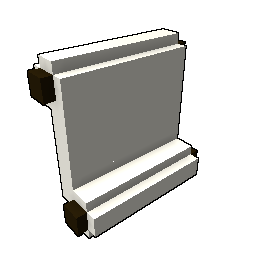

The .dungeon file is the property\settings file of your dungeon. This chapter in the dungeoneering 101 will focus on creating the .dungeon file in a readable format.
The .dungeon file is the property file of your dungeon. It tells the server the number of times your pieces can be picked. On top of that, it also incorporates the chance a certain piece can spawn. You can edit your .dungeon file in any text editor, but if you like formatting open it up in Programmers notepad for example. Switch the formatting to "properties" and you will see the difference between segments.

Image 1. Normal notepad on the left versus programmers notepad on the right.
This guide covers a lot of additional information that will help you make your .dungeon file more readable for both you, the TroveCreations Moderators and the Development team.
Please note that naming of the file doesn't affect if it works or not, but it's much easier to keep track of files when its named properly instead of qwerty.dungeon
Step 1. Create a txt-file
The .dungeon file has to be right next to the blueprints of your dungeon, so Right-click in the folder where you have them, browse to New and choose Text Document.
Rename your text file corresponding to your dungeon filenames and replace the .txt with .dungeon.
Example:
We create .txt file in the folder we working on, then we rename it to guidehouse and change file extension to .dungeon

Advanced Naming!
This next bit is not mandatory, but it can be helpful for developers if you name your files according to a template. However, it is absolutely fine to name your dungeon files as you please, as long as it is understandable.
In game files dungeons use following naming: E_{type}_{biome}_{identifier}
- E_D1_cursed_brokentomb
Which would translate as Environment, Dungeon 1 star, Cursed Vale biome, Broken tomb (name of the dungeon)
- E_D3_frontier_westerntown
Which would translate as Environment, Dungeon 3 star, Desert Frontier biome, Western Town dungeon
- E stand for environment
- the {type}: D1 stands for Dungeon one star = lair, D3 stand for Dungeon three stars = dungeon, 5 stands for Dungeon 5 stars (Geode Topside)
- the {biome} is filled with the biome name
- the {identifier} is a unique name for that dungeon, usually represents what the dungeon is meant to be. A tomb, a crypt etc.
Step 2. Fill the file (Header info)
Before we start adding the individual pieces, we will start on the "header bit".
- Line 1: Always start your file with
[Dungeon]. - Line 2: If you're making a Lair (1-star), you will need to add the following line on line 2: "
Type = lair". If you're making a 3-star dungeon, add "Type = Dungeon" instead. - Line 3+: these are optional and added as comments. These are used to make the file more readable.
Every line starting with a "#" will be a comment field. It is not required to use those, but comments can be really helpful if your dungeon consists of 10 or more different blueprints.
In the dungeon file quotes (") are not used, but in this guide, we use them to highlight the text you need to add.
Example so far:
[Dungeon]Type = lair#Creator = Evilagician#Dungeon name = Guidehouse
Means that the .dungeon file you are looking at will assemble a Lair (1-star dungeon). Commented (#) lines are there just to add a bit of additional information.
Step 3. Fill the file more (piece level)
Now it is time to add each individual piece. The order doesn't really matter but it's advised to work your way down in the logical order of how the rooms in your dungeon spawn.
Each of the pieces you add to the file must have unique name. For example [Piece1], [Piece2], [Piece3] etc. For each piece it is mandatory to fill the following fields:
[uniquename]Blueprint = {blueprintname, exactly as you blueprint named, without file extension}Quantity = {amount of times that piece can be picked, whole numbers starting 1 and up}Weight = {percentage chance of it to spawn, a fractional number from 0 to 1, with a step of 0.1}
Example:
[Dungeon]Type = lair#Creator = Evilagician#Dungeon name = Guidehouse
[Piece1]
Blueprint = guidehouse_base
Quantity = 1
Weight = 1
[Piece2]Blueprint = guidehouse_door
Quantity = 1
Weight = 1
This means, that guidehouse_base.blueprint can spawn 1 time with a 100% chance, its unique name is Piece1. Same goes for guidehouse_door.blueprint, it can spawn 1 time with a 100% chance and its unique name is Piece2.
Lets add all the pieces to the file.
Complete .dungeon file for our example house:
[Dungeon]Type = lair#Creator = Evilagician#Dungeon name = Guidehouse
[Piece1]
Blueprint = guidehouse_base
Quantity = 1
Weight = 1
[Piece2]Blueprint = guidehouse_door
Quantity = 1
Weight = 1
[Piece3]Blueprint = guidehouse_wall
Quantity = 2
Weight = 1
[Piece4]Blueprint = guidehouse_window
Quantity = 1
Weight = 1
[Piece5]Blueprint = guidehouse_roof
Quantity = 1
Weight = 1
Note that guidehouse_wall.blueprint has its Quantity set to 2, this means the Blue Wall piece can spawn 2 times, if there are available sockets for that to happen.
Our .dungeon file is complete, but there are a few things to keep in mind. The Weight is a percentage on a separate piece. This doesn't mean the sum of all the pieces has to be 100%.
Quantity has to be more or equal to the number of sockets you have in your dungeon (of that type). Else there will be empty sockets and dungeon will not spawn.
Step 4. Completion (for now)
Save your file. In the next step of this guide, we will test the dungeon and fix possible errors. When you add more pieces to your dungeon, you should always adapt the .dungeon file too, simply adding blueprint into the folder will not work.
<- Chapter 4 | Intro and Table of Contents | Chapter 6 ->
Page Change Log
- 2018-09-24: Written
- 2019-03-05: Published



